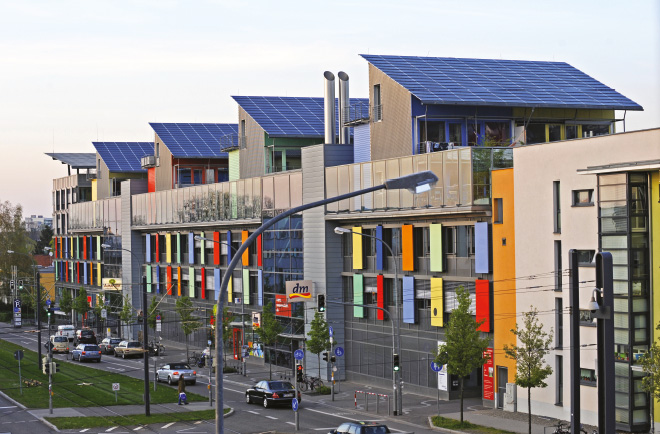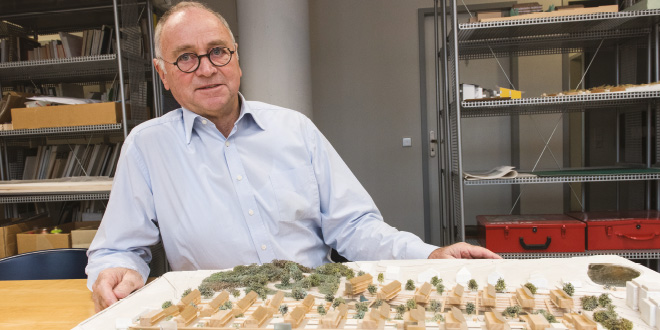Rolf Disch, who was born in 1944, is an architect. He lives and works in Freiburg, Germany. Disch became well known thanks to his special architectural achievements in the field of solar house construction. In 2003, he won the Global Energy Award for this. He is the inventor and designer of the energy-plus houses. In 2009, he won the Utopia Award. Characteristic of his renovated and newly-built houses, housing schemes and office buildings is the fact that they are CO2-neutral and architecturally unique. They produce more energy than they consume. ECO123 visited this pioneer in the cabin of his “sunship”.
How does the 72-year-old architect get to work in the morning?
By bicycle. It can be folded, and taken on a tram or a train. I always have it with me: even when I was recently in Vienna on business too. I covered 70 km by bike. The bike is sturdy and it’s good for me. I haven’t seen any need yet to acquire an electric car. We also have three spaces here for car sharing. Now we want to install a charging point in front of our office. We’re just waiting for approval from the city.
What induced you to construct solar cars, with which you won world championships in Australia?
In 1987, I took almost the whole year to build my vehicle for the Tour de Sol in Australia. After the race, the Australian Mercedes manager was very interested in me building and driving a car for Mercedes three years later. Then he contacted the management in Germany and they were very interested. I was asked to make them an offer. They passed it on to Aerospace because the vehicle used lightweight materials. But it was too expensive for them in those days. Later I also won a race in Switzerland against the Formula 1 driver Marc Surer. The two solar vehicles are still in the museum. They were the first of their kind. But if you’re an architect, you prefer to build houses.

You didn’t start working yesterday. How did it all start?
It began much earlier, in 1969. I started in my architecture practice with social projects: so, kindergartens, youth centres, schools for the disabled, homes for the elderly. That was my field. I was nicknamed a social architect. I always took on concrete tasks and then designed solutions for them.
You have to have dreams in order to think of ideas and then to make plans from them. What was the breeding ground for your ideas?
You have to be inventive. I trained as a carpenter. When I was 14, I went off on construction jobs, with my tool box on my bicycle luggage rack. Just imagine. After three years, I was a journeyman carpenter, but then I also trained for two years as a bricklayer because I wanted to be an architect. While I was studying, I also attended welding courses. That was a benefit for me when building vehicles. I was able to solder the vehicles’ wafer-thin pipes together.
When you think about the future of the house, what ideas do you have?
I think of towns and communities that need a sustainable housing stock. Where people think about new housing developments and the restoration of districts or villages, where young families can be attracted and kept, where multi-generational projects create attractive living space for young and old; people need to think and plan 50 years ahead, and with conviction. It is this credible vision of a commune that makes the difference between people moving to a place and moving away from it, for or against private or business investments. Such an energy-plus house is immensely attractive because owners can earn money in a clean manner and save on fixed costs every month. It embodies modernity, a sustainable lifestyle, even luxury in the best sense of the word, in short everything that a community would like to demonstrate. And the new building standard is a signal to everyone that we are thinking about future generations.

How does an energy-plus house work?
The key to this type of house is the sun. The roof consists of the biggest possible photovoltaic system, and solar thermal panels heat the water. The traditional use of the roof overhang shields the house from the high summer sun, while the rays of winter sunshine penetrate deep into the interior. The triple glazing on the south-facing façade, which is highly translucent and reflects infrared light, simultaneously retains warmth in the house. The entire building envelope is insulated to avoid thermal bridges and is tightly sealed. The ventilation system with heat recovery makes it possible for fresh air to be supplied with almost no heat loss.
What difficulties do architects face when they wish to implement innovative ideas?
Financing was always an issue, because there was never any money. As soon as an architect has to deal with the authorities, things also become difficult. Above all, it becomes difficult when someone else has to assume responsibility. One must always assume responsibility oneself.
How do you live when you know that you belong to a minority of architects who want to build sustainably?
Well, actually. But when you are aware of the problems that we will face as a society, you find that more difficult to live with. I always ask myself: how can I inspire and win someone over? And I can see that people have to change, have to transform themselves. That is almost an insoluble task.
Can you please explain to us how that is done? Because most people live in a world in which they have made themselves comfortable, where they have got used to electricity simply coming out of the socket.
In May 2000, we presented the first five houses. We held an open day. People came with all the prejudices you can imagine. The houses were too expensive for them. That had already been in the papers. Another argument was that a house must breathe. And another was that you couldn’t even open the windows in the houses.
How did you overcome these prejudices?
Through complete transparency and increasingly with improved technology. Laws appeared on feed-in tariffs for renewable energy in Europe and suddenly it was worth selling electricity. We even enlarged the roofs with the solar modules. It wasn’t easy. Nowadays, none of that is a problem any more. Today people know that the houses have proved themselves. There are people living in them, who can attest to that.
Using natural materials is not only good for the natural environment on our earth, but also for people’s built environment. After all, we spend more than 50% of our lives indoors. The energy-plus house avoids all harmful materials in both living areas and work spaces. All the building materials must be emission free. Together with modern ventilation systems, and without air-conditioning that wastes energy, the energy-plus approach to building guarantees permanent fresh, healthy air at the correct temperature.
Don’t you feel sometimes that this is all coming much too late? Politicians who get elected in order to change something are themselves changed by the system instead of changing the system in which we live.
First you have to find the politician who wants to change something, who has a vision, who is ready to fight for that. There aren’t many. It is extremely difficult to pursue your policies when you’re faced with a lobby of conservative property developers.
How are we going to implement COP21?
I think that will take some time. Instead of sitting down and thinking about what needs to be done in concrete terms, we spend all of our time rushing around. I’m going to be in Berlin again next week where there will once again be general meetings, but nothing specific will be achieved. It is always about jobs. Job losses are always threatened and then everything just keeps going as before.
I come from a small village in south-west Portugal where half the houses are empty and are slowly turning into ruins. What could be changed there, and where do you start?
You take one of the many ruins and restore it. I would look for a sponsor who could finance that. Build a model house to show what can be achieved. I would look at the climate. You would have to try to get through the heat of the day with the cooling of the night. Use the best insulation, on the roof too. Use a solar roof, because you can also use the sun’s energy for cooling, thermally or with electricity. And then I would look at how people used to do it before, the grandparents. What materials were used for building houses? Clay? Granite? Slate? Check where the wastewater goes. Is there a biological treatment system with plants on site? Or a drying plant?

How much would a model house like that cost – with a living area of 150 to 200 m2?
That is very difficult to say. You would probably need to renew the walls, the roof, the windows. How much do tradespeople cost locally? What materials and technologies are we going to use? But at the end there would be no more energy costs. Feed it into the grid, or build up your own network near a village. Or install an electric charging point and use the solar power. I estimate that you would have to allow for perhaps 300,000 euros to renovate a house like that, maybe slightly less. You would have to try it. If you were to renovate a whole residential estate, you would get support from Europe. Something has to happen in Portugal. Young people have to be given prospects, and jobs need to be created in sustainable professions. Natural energy is widely available in Portugal. You just need the technology and the labour. Then you save oil, gas and coal. I once heard that a tanker comes to deliver crude oil to us and takes our money back on the return journey …
But to put an idea into practice, you need money…
…if an idea is good enough, the money comes along almost by itself. When renovating houses, you optimise them, by integrating solar technology and insulation too. An energy-plus house is totally supplied by renewable energy. It is run CO2-neutrally. It reduces consumption to such an extent that it produces more energy than it consumes. Added to this is the selection of building materials that are healthy for living. This can be financed not only with one’s own capital, but also through public subsidies, with crowdfunding and donations, with funds that one sets up. You set up cooperatives. Germany could help here with expertise – through different types of cooperation: in the field of research and development, as well as joint model projects, project development and implementation. We could assist with setting up a 100% regenerative energy system in Portugal, with the efficient handling of energy in urban redevelopment and the renovation of buildings, for example, as well as with studies on the impact of the electrification of transport and the use of autonomous vehicles with new business models, job creation, urban and rural developmen, and in setting up a successful dual education system. After all, that is the point of the European partnership.
What is needed?
On the one hand, the awareness of being able to change something for the better. On the other hand, there are too many people who are simply self-satisfied. They’re too comfortable and don’t participate. An energy-plus house supports itself. From the data gathered from the solar housing scheme here, an average house was defined: with an average of three people, 137 m2 heated living space and a 49 km2 solar power system with 6.3 kWp nominal output. This house consumes 79 kWh/m2 per year, but produces 115 kWh/m2 per year. So the surplus amounts to around 36 kWh/m2 in primary energy.
What is that in financial terms?
For 100 m2, that amounts to additional construction costs of 40,000 euros. The profits amount to some 21,000 euros over ten years, over 15 years 31,500 euros and as much as 42,000 euros over 20 years.
Many thanks for talking to us.
ROLF DISCH
 Eco123 Revista da Economia e Ecologia
Eco123 Revista da Economia e Ecologia


